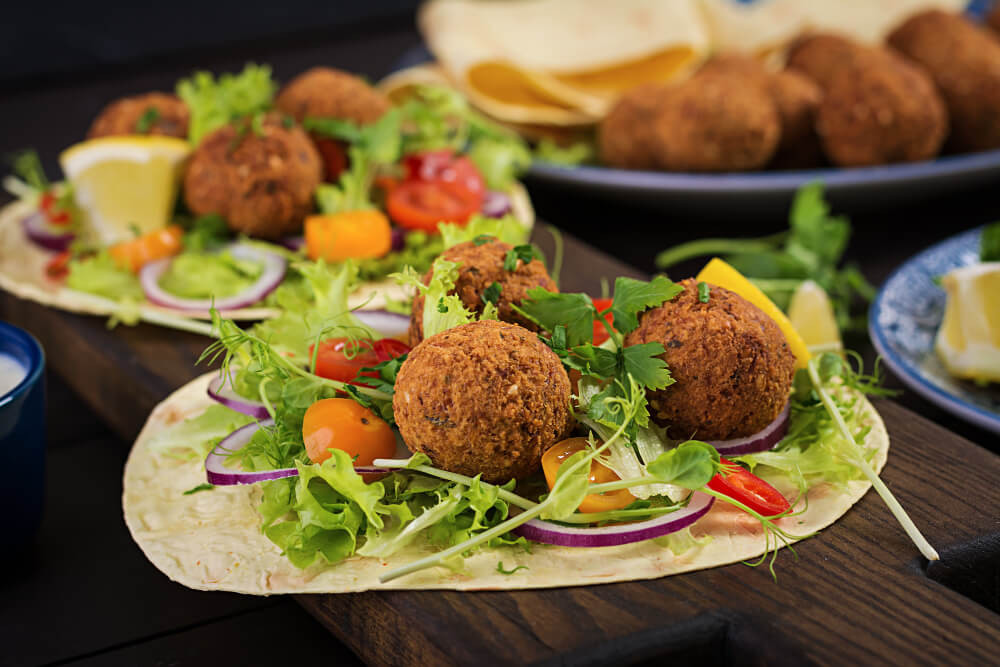| Rosette Rafaat | 2024-02-26 10:10:53 |
Exploring the vibrant Egyptian cuisine unveils a rich culinary heritage steeped in history and cultural diversity. From the crowded streets of Cairo to the serene banks of the Nile, the Egyptian food list reflects the country's complex past and its geographical bounty.
With influences from ancient civilizations such as the Pharaohs, as well as contributions from Mediterranean, Middle Eastern, and African cultures, Egyptian dishes are full of charmed taste with a symphony of flavors and aromas. Join Manta Tours on a journey through the land of the pyramids as we delve into the essence of Egyptian food culture and the stories they tell.
Ancient Egyptian Food
Ancient Egyptian cuisine was a fascinating blend of simplicity and sophistication, reflecting the agricultural abundance of the Nile River Valley and the rich cultural traditions of the time. Here are the following of Egyptian food menu:
-
Bread made from wheat
-
Beer, consumed by adults and children
-
Vegetables like onions, garlic, leeks, lettuce
-
Fruits such as Figs, dates, melons
-
Protein sources like fish from the Nile, poultry, occasional red meat
-
Sweetener such as honey
-
Spices like coriander, cumin, among others
Traditional Egyptian Food
Traditional Egyptian cuisine offers a delightful variety of flavors and textures, reflecting the country's diverse culinary heritage. Here are some examples of traditional Egyptian dishes:
-
Koshari: A popular street food dish made with rice, lentils, macaroni, chickpeas, and topped with a spicy tomato sauce and crispy fried onions.
-
Ful Medames: A hearty breakfast dish consisting of mashed fava beans seasoned with olive oil, garlic, and lemon juice, typically served with bread.
-
Molokhia: A nutritious soup or stew made from jute leaves, cooked with garlic, coriander, and sometimes meat, served over rice or bread.
-
Mahshi: Vegetables such as eggplant, zucchini, and bell peppers stuffed with a mixture of rice, herbs, and occasionally ground meat, then simmered in a tomato-based sauce.
-
Ta'meya (Egyptian Falafel): Deep-fried balls made from crushed fava beans mixed with herbs and spices, often served in pita bread with salad and tahini sauce.
-
Roz bel Laban: A creamy rice pudding flavored with rose water and garnished with nuts or raisins, served as a dessert.
Top 10 Food in Egypt: Popular Egyptian Food and Drink
Certainly! Here's a list of the top 10 popular Egyptian food and drinks:
-
Roz bel Laban: A creamy rice pudding flavored with rose water and garnished with nuts or raisins, served as a dessert.
-
Hawawshi: Spiced ground meat (usually beef or lamb) stuffed inside a pita bread and baked or grilled until crispy.
-
Fiteer: Egyptian pastry made of thin layers of dough, often stuffed with various fillings like cheese, meat, or sweet ingredients like honey and nuts.
-
Shawarma: Marinated meat (typically chicken or beef) roasted on a vertical rotisserie and sliced thinly, served in a pita wrap with salad and tahini sauce.
-
Mulukhiyah Soup: A hearty soup made from the leaves of the molokhia plant, cooked with garlic, coriander, and often served with chicken or rabbit.
-
Baba Ghanoush: A smoky eggplant dip mixed with tahini, garlic, lemon juice, and olive oil, often served as an appetizer with bread.
-
Fatta: A festive dish made with layers of rice, crispy bread, and pieces of meat (usually lamb or beef), all soaked in a flavorful broth and topped with a garlic-tomato sauce.
-
Basbousa: A sweet semolina cake soaked in syrup, flavored with rose water or orange blossom water and sometimes topped with almonds or coconut flakes.
-
Baladi Bread: Traditional Egyptian bread, usually made from whole wheat flour and baked in wood-fired ovens, serving as a staple accompaniment to many meals.
-
Sobia: A refreshing Egyptian drink made from coconut milk, sugar, and flavored with rose water or other aromatic ingredients.
Conclusion
In conclusion, Egyptian cuisine is vibrantly woven with history, culture, and a bounty of flavors. From the streets of Cairo to the banks of the Nile, traditional dishes like Koshari, Ful Medames, and Roz bel Laban offer a glimpse into the rich culinary heritage of this ancient land.
Influenced by a myriad of civilizations and enriched by the fertile lands of the Nile River Valley, Egyptian food reflects the ingenuity and resourcefulness of its people. Whether it's the aromatic spices, hearty stews, or sweet desserts, every bite tells a story of resilience, tradition, and community.
As we celebrate the diversity and complexity of Egyptian cuisine, we also honor the generations of cooks who have passed down these cherished recipes, ensuring that the flavors of Egypt continue to delight and inspire for generations to come. So let us raise our glasses of Sobia and share in the joy of a culture united by its love for good food and warm hospitality. Ma’a as-salama! (Goodbye in Arabic). Just book a private tour with Manta Tours to taste all those Egyptian dishes.
FAQs
What were 5 foods that Egyptians ate?
Ancient Egyptians consumed a variety of foods including bread made from emmer wheat, a staple in their diet. They also ate vegetables like onions, garlic, and lettuce, along with fruits such as figs and dates. Fish from the Nile and occasional red meat supplemented their meals, offering nutritional diversity.
Is the food in Egypt good?
Yes, the food in Egypt is widely regarded as delicious and diverse. Egyptian cuisine offers a rich array of flavors, textures, and aromas, reflecting the country's cultural heritage and the abundance of fresh ingredients. From street food delicacies to traditional home-cooked meals, Egypt offers a culinary experience that satisfies both locals and visitors alike.
What is a typical Egyptian breakfast?
A typical Egyptian breakfast often includes Ful Medames, which are mashed fava beans seasoned with olive oil, garlic, and lemon juice, served with bread. Other common items may include cheese, eggs, tomatoes, cucumbers, olives, and tahini. Tea or coffee is also commonly enjoyed alongside breakfast.
